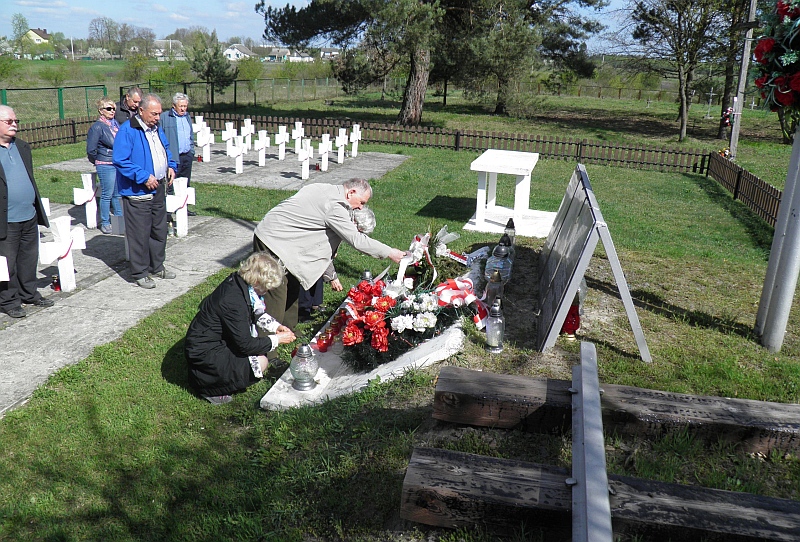 W czwartek 19 kwietnia 2018 r., trzydziestu czterech członków Towarzystwa Miłośników Wołynia i Polesia Oddział w Chełmie odwiedziła Rymacze i Luboml na Wołyniu.
W czwartek 19 kwietnia 2018 r., trzydziestu czterech członków Towarzystwa Miłośników Wołynia i Polesia Oddział w Chełmie odwiedziła Rymacze i Luboml na Wołyniu. 2018-04-22
 W czwartek 19 kwietnia 2018 r., trzydziestu czterech członków Towarzystwa Miłośników Wołynia i Polesia Oddział w Chełmie odwiedziła Rymacze i Luboml na Wołyniu.
W czwartek 19 kwietnia 2018 r., trzydziestu czterech członków Towarzystwa Miłośników Wołynia i Polesia Oddział w Chełmie odwiedziła Rymacze i Luboml na Wołyniu.
W Rymaczach odwiedziliśmy Cmentarz Wojenny 27 Wołyńskiej Dywizji Armii Krajowej z okazji 74 rocznicy bitwy stoczonej przez Dywizję z wojskami niemieckim w pobliżu Rymacz w dniu 21 kwietnia 1944 roku. Przypomina o tym skromny pomnik w postaci toru kolejowego umieszczonego na specjalnie przygotowanym nasypie a na tablicach epitafijnych u stóp metalowego krzyża znajduje się 81 nazwisk żołnierzy poległych w tej bitwie. Pod krzyżem złożono wieniec i zapalono znicze a prezes Oddziału Stanisław Senkowski zapoznał uczestników z historią dywizji i bitwy...
On 19 April 2018 a group of 34 members from Polish Association of Volyn and Polesie Enthusiasts in Chełm visited Rymacze and Luboml in Volyn. In Rymacze we visited the national memorial of the 27 Home Army Division in Volyn; it was, on 21 April 1944, for the time of celebration of the 74th battle’s Anniversary fought against the German army near Rymacze. This fact is reminded by the humble monument in shape of the railway track placed in the special embankment prepared for this purpose; and the epitaph memorials at the feet of the metal cross include 81 soldiers’ names deceased in this battle. The candles were lit and a wreath was laid in memory of the fallen; and a president of the Polish Association of Volyn and Polesie Enthusiasts, Mr Stanisław Senkowski told the members of the unit about the Division’s history and its battle...
W drodze na cmentarz żolnierzy polskich w Rymaczach.


Cmentarz Wojenny 27 Wołyńskiej Dywizji Armii Krajowej





W Lubomlu dzięki uprzejmości księdza Jana Burasa mogliśmy zwiedzić wnętrze kościoła pw. Świętej Trójcy, który jest najstarszą świątynią katolicką na Wołyniu. Kościół powstał z fundacji króla Władysław Jagiełły w roku 1412 i w dobrej kondycji dotrwał do września 1939 roku.
Władza sowiecka przyczyniła się do jego ogołocenia z wewnętrznego wystroju i znacznego zniszczenia murów w wyniku przechowywania wewnątrz soli potasowej. Obecna Parafia w Lubomlu liczy 15 parafian. Nasze odwiedziny są okazją do wsparcia finansowego parafian w utrzymaniu przy życiu naszego dziedzictwa narodowego pozostającego na Wołyniu. Po wspólnym obiedzie w Lubomlu o godzinie 14.00 udaliśmy się do Chełma.
Na granicy polskiej grupa nasza poddana została szczegółowej kontroli celnej, która trwała półtorej godziny ale była bezowocna.
Ostatnio celnicy z ogromną wytrwałością i skrupulatnością szukają wpływów do budżetu, efektem czego jest upokarzanie i naruszanie godności osób wjeżdżających z Ukrainy do Polski.
Tekst i zdjęcia - Stanisław Senkowski
In Rymacze and Luboml
On 19 April 2018 a group of 34 members from Polish Association of Volyn and Polesie Enthusiasts in Chełm visited Rymacze and Luboml in Volyn. In Rymacze we visited the national memorial of the 27 Home Army Division in Volyn; it was, on 21 April 1944, for the time of celebration of the 74th battle’s Anniversary fought against the German army near Rymacze. This fact is reminded by the humble monument in shape of the railway track placed in the special embankment prepared for this purpose; and the epitaph memorials at the feet of the metal cross include 81 soldiers’ names deceased in this battle. The candles were lit and a wreath was laid in memory of the fallen; and a president of the Polish Association of Volyn and Polesie Enthusiasts, Mr Stanisław Senkowski told the members of the unit about the Division’s history and its battle. Thanks to Prester John Buras and his kindness we were allowed to visit the inside of the Holy Trinity Church in Luboml, which is the oldest Catholic temple in Volyn. This church was built in 1412 thanks to the King Władysław Jagiełło’s benefaction and remained unaffected since September 1939. Its inner parts were soon later stripped by the Soviet authorities and due to the potassium chloride inside the sides were destroyed. Presently, the congregation in Luboml consists of the 15 parishioners. Our visit is the occasion to support financially the parishioners in order to preserve our national patrimony remaining in Volyn alive. After dinner in Luboml, we went to Chełm at 14 o’clock. Our group was supervised carefully by the customs check at the Borders of Poland and it lasted half and an hour; however, it was unsuccessful. Recently, the customs officers have been searching persistently and scrupulously for the goods to their budget; and as a consequence, the people coming back to Poland from the Ukraine experience humiliation and violation of their dignity.
Author: Stanisław Senkowski
Translation: Ewa Moradewicz-Paszko